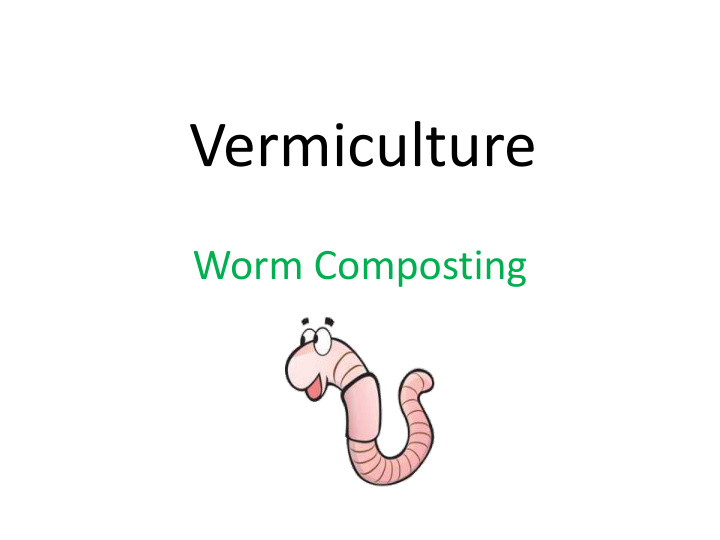



Vermiculture Worm Composting
Vermiculture: the process of using worms to turn your household and kitchen waste into compost.
Three Methods of Composting Cold Compost – not actively worked Hot Compost – actively worked – tumbled or stirred Worm Compost – cold compost that is actively worked - stirred
All 3 types of composting: Use micro-organisms to break down material Require moisture Can be done outdoors
Worm compost: Combination of worm castings (poop), decomposed organic matter that didn’t pass through the worm and partially decomposed organic matter that is still somewhat recognizable. It contains 5 times the nitrogen, 7 times the phosphate and 10 times the pot ash than other types of compost. It has 1 ½ times more calcium than average top soil.
Worm composting advantages: • Less time required to manage • Very high humus content • Contains slow release natural fertilizers • Concentrated water soluble nutrients that plants can use immediately • Produces compost quicker
Worm composting advantages (cont.): • Helps bring soil particles together • Enhance disease resistance • Encourages strong and healthy root systems • Produces strong healthy plants and crops • Greater water absorption and holding capacity
Worm facts: Over 4,400 species of worms in the world Originated in Asia , Europe and Middle East. Later introduced to Africa and the Americas Can be found in all climates except for the harshest deserts and artic regions Many are hermaphrodites – have both male and female parts – but still mate Average population per acre in US is 53,767
Red Wriggler Worms
Red Wrigglers Disintegrate when they die adding more nutrients to the compost Ferocious eaters. Can eat ½ their body weight every day. If you start with one pound of worms you need to feed them 3 ½ pounds of food per week In confinement they can live up to 4 years and can grow up to 3 inches long Can live in a wide range of temperature but are happiest from 40 to 80 degrees Happy worms reproduce quickly in confinement. Their population may double or even triple in one year Watermelon is their favorite food but will eat anything organic except for citrus, dairy and meat
Managing a worm compost bin 1. Feed them 50% green (nitrogen) and 50% brown (carbon) foods 2. Carbon to nitrogen ratio ranging from 25:1 to 30:1 is the dividing line between green and brown foods 3. Greens: fruits, vegetables, pasta, crackers, coffee grounds 4. Browns : newspaper, cardboard, dried leaves from deciduous trees, junk mail, coconut coir 5. No grass clippings because they produce too much heat 6. Feed them extra before a long trip – 2 to 3 weeks 7. Moisture should be 60 to 75% 8. Ideal Ph level is 6-7 or neutral
Thank you!
Recommend
More recommend